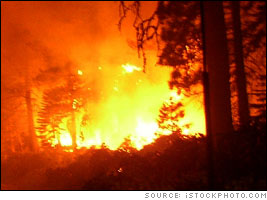Science News: Unpredictable Weather

Climate and Weather: 2013 Proved That Surprises Are Possible
by Catherine McNiff
The Nobelist Particle | Unpredictable Weather | Close Encounter with a Second Sun | Problem with Plan B | The Truth About Molly and Other Party Drugs A Twist on Climate ChangeIn Sept. 2013, the Intergovernmental Panel on Climate Change (IPCC), a United Nations body, released a summary for policymakers on the physical science portion of its Fifth Assessment Report (AR5) on global climate change, due out in 2014. The conclusions include two bright spots: recognition of a climate sensitivity lower than previously thought and a “pause“ in the rise of surface air temperatures, along with a wake up call: an increase in radiative forcing, caused by human activity. Looking at the period from 1950–2010, the report states with about as much certainty as is allowed in science that it is “extremely likely“ that "half of the observed increase in global average surface temperatures since the 1950s" is due to human activity. This is a change in terminology and outlook that is quite marked; human activity and climate change were first tentatively linked in 1995, then called “likely“ in 2001, and “very likely“ in 2007. The report marks a shift away from the emphasis on greenhouse gases in 2007's AR4 to a growing awareness of the effects of radiative forcing, which is the difference between the amount of heat coming into the climate and the amount reflected back. The heat generated by us post-industrialization is not effecting as dramatic a rise in surface air temperatures as the IPCC had expected and predicted, but is, it is now believed, being absorbed in the deepest, darkest, and coldest parts of the world's oceans. Long-term consequences of this include a rise in sea level, a shrinking of ice and snow cover, and the melting of glaciers. So, while certain aspects of climate change aren't quite as dire as previously predicted, the bottom line is a serious one: climate change is a reality that will be part of our lives forever. Weather patterns that were decades ago considered natural phenomena, are now recognized as equally inevitable, but unfortunately man-made, products of choices we have made since the middle of the 19th century. The heat generated by radiative forcing, coupled with the well-established problems caused by CO2 emissions are not painting a rosy picture. New to this year's report, in fact, is a carbon budget aimed at keeping global warming below 2ºC, which “will require cumulative CO2 emissions from all anthropogenic sources to stay between 0 and about 1,000 [trillion tons].“ As we have cumulatively already used up more than half that amount as of the current year, the likelihood of continued climate change is one constant we can count on. 2013 Wildfire SeasonWhile it is a natural inclination to link climate change with extreme weather, such as tornadoes and wildfires, the opinions of experts are mixed. What is incontrovertible is that humans and their activities are implicated in both climate change and extreme weather events. In the case of wildfires, geography and climate are the first variables in the equation, followed by the human catalyst—both intentional and accidental—and then weather seems to simply take over. In terms of numbers of fires and acres burned, the 2013 season was well under the 10-year average (2004–2013) of 69,263 wildfires and 6,843,298 acres, totaling 45,061 wildfires and 4,157,061 acres. Chuck Wamack of the National Interagency Coordination Center (NICC) attributes the “moderate“ fire season to increased rain in the eastern part of the United States, which put a welcome damper on the southern wildfires. However, as is often the case, the numbers don't tell the whole story. According to Ken Frederick of the National Interagency Fire Center (NIFC), 2013 was a “tough year,“ with many communities, towns, and cities threatened. Thousands felt fire's destructive forces most keenly—from June's unprecedented Black Forest fire in Colorado to the two-month fire in Yosemite, and the loss of more than thirty fire personnel in the line of duty, including 19 Granite Mountain Hotshots killed in the worst single accident in decades in Arizona's Yarnell Hill Fire. 2013 Tornado SeasonAccording to the National Weather Service and the NOAA's Storm Prediction Center, 2013 was a relatively quiet year, tornadically speaking. Like 2012, this year experienced tornado numbers that were below average, and the preliminary figures show a total of 927 tornadoes, making 2013 one of only 3 years since 1990 to stay below 1,000. Unlike last year, which was dry and hot, 2013's unseasonably cold spring was the reason for suppressed tornadic activity. Late May was an exception to the below-average year, with a period of storms that was heavier than usual and included a devastating EF5 tornado—1.3 miles wide and 17 miles long—that ripped through Moore, Oklahoma, on May 21, killing 24. While May is, on average, the most active month for tornadoes, November and December are known for being the quietest. Except in 2013, when there were 111 preliminary tornado reports, hitting a mark well above the 1991–2010 average of 58. A majority of twisters, 106, occurred on a single day—November 17th, with Indiana and Illinois hardest hit.
|









